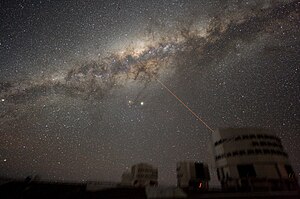 |
| An image of the Milky Way in the night sky above Paranal |
The Milky Way is the galaxy that contains our Solar System. Its name "milky" is derived from its appearance as a dim glowing band arching across the night sky in which the naked eye cannot distinguish individual stars. The term "Milky Way" is a translation of the Latin via lactea, from the Greek γαλαξίας κύκλος (galaxías kýklos, "milky circle"). From the Earth, the Milky Way appears like a band because its disk-shaped structure is viewed from within the Galaxy. Galileo Galilei first resolved the band of light into individual stars with his telescope in 1610. In the past, astronomers thought that all of the stars in the universe were contained inside of the Milky Way. Following the 1920 Great Debate between the astronomers Harlow Shapley and Heber Curtis, observations by Edwin Hubble definitively showed that the Milky Way is just one of many galaxies.
The Milky Way is a barred spiral galaxy some 100,000–120,000 light-years in diameter which contains 100–400 billion stars. It may contain at least as many planets as well. The Solar System is located within the disk, about 27,000 light-years away from theGalactic Center, on the inner edge of a spiral-shaped concentration of gas and dust called the Orion–Cygnus Arm. The stars in the inner ≈10,000 light-years form a bulge and one or more bars that radiate from the bulge. The very center is marked by an intense radio source named Sagittarius A* which is likely to be a supermassive black hole.
Stars and gases at a wide range of distances from the Galactic center orbit at approximately 220 kilometers per second. The constant rotation speed contradicts the laws of Keplerian dynamics and suggests that much of the mass of the Milky Way does not emit or absorbelectromagnetic radiation. This mass has been given the name "dark matter". The rotational period is about 240 million years at the position of the Sun. The Galaxy as a whole is moving at a velocity of approximately 600 km per second with respect to extragalactic frames of reference. The oldest known star in the Galaxy is at least 13.6 billion years old and thus must have formed shortly after the Big Bang. Surrounded by several smaller satellite galaxies, the Milky Way is part of the Local Group of galaxies, which forms a subcomponent of the Virgo Supercluster.
Appearance
Formation
Environment
Appearance
When observing the night sky, the term "Milky Way" is limited to the hazy band of white light some 30 degrees wide arcing across the sky (although all of the individual stars that can be seen with the naked eye are part of the Milky Way Galaxy). The light in this band originates from un-resolved stars and other material that lie within the Galactic plane. Dark regions within the band, such as the Great Rift and the Coalsack, correspond to areas where light from distant stars is blocked by interstellar dust.
The Milky Way has a relatively low surface brightness. Its visibility can be greatly reduced by background light such as light pollution or stray light from the moon. It is readily visible when the limiting magnitude is +5.1 or better, while showing a great deal of detail at +6.1. This makes the Milky Way difficult to see from any brightly lit urban or suburban location but very prominent when viewed from a rural area when the moon is below the horizon.
As viewed from Earth, the visible central region of the Milky Way occupies an area of the sky that includes 30 constellations. The center of the Galaxy lies in the direction of theconstellation Sagittarius; it is here that the Milky Way is brightest. From Sagittarius, the hazy band of white light appears to pass westward to the Galactic anticenter in Auriga. The band then continues westward the rest of the way around the sky back to Sagittarius. The band divides the night sky into two roughly equal hemispheres.
The Galactic plane is inclined by about 60 degrees to the ecliptic (the plane of the Earth's orbit). Relative to the celestial equator, it passes as far north as the constellation ofCassiopeia and as far south as the constellation of Crux, indicating the high inclination of Earth's equatorial plane and the plane of the ecliptic relative to the Galactic plane. The north Galactic pole is situated at right ascension 12h 49m, declination +27.4° (B1950) near β Comae Berenices, and the south Galactic pole is near α Sculptoris. Because of this high inclination, depending on the time of night and the year, the arc of Milky Way can appear relatively low or relatively high in the sky. For observers from about 65 degrees north to 65 degrees south on the Earth's surface the Milky Way passes directly overhead twice a day.
Size and mass
The stellar disk of the Milky Way Galaxy is approximately 100,000 ly (30 kpc) in diameter, and is, on average, about 1,000 ly (0.3 kpc) thick. As a guide to the relative physical scale of the Milky Way, if it were reduced to 100 m (110 yd) in diameter, the Solar System, including the hypothesized Oort cloud, would be no more than 1 mm (0.04 in) in width, about the size of a grain of sand. The nearest star, Proxima Centauri, would be 4.2 mm (0.2 in) distant. Alternatively visualized, if the Solar System out to Pluto were the size of a US quarter (25 mm or 1 in in diameter), the Milky Way would have a diameter of 2,000 kilometers, an area approximately one-third the size of the United States.
Estimates for the mass of the Milky Way vary, depending upon the method and data used. At the low end of the estimate range, the mass of the Milky Way is 5.8×1011 solar masses (M☉), somewhat smaller than the Andromeda Galaxy. Measurements using the Very Long Baseline Array in 2009 found velocities as large as 254 km/s for stars at the outer edge of the Milky Way. As the orbital velocity depends on the total mass inside the orbital radius, this suggests that the Milky Way is more massive, roughly equaling the mass of Andromeda Galaxy at 7×1011 M☉ within 160,000 ly (49 kpc) of its center. A 2010 measurement of the radial velocity of halo stars finds the mass enclosed within 80 kiloparsecsis 7×1011 M☉. Most of the mass of the Galaxy appears to be matter of unknown form which interacts with other matter through gravitational but not electromagnetic forces; this is dubbed dark matter. A dark matter halo is spread out relatively uniformly to a distance beyond one hundred kiloparsecs from the Galactic Center. Mathematical models of the Milky Way suggest that the total mass of the entire Galaxy lies in the range 1–1.5×1012 M☉.
Stars and planets
The Milky Way contains at least 100 billion stars and may have up to 400 billion stars. The exact figure depends on the number of very low-mass, or dwarf stars, which are hard to detect, especially at distances of more than 300 ly (90 pc) from the Sun. As a comparison, the neighboring Andromeda Galaxy contains an estimated one trillion (1012) stars. Filling the space between the stars is a disk of gas and dust called the interstellar medium. This disk has at least a comparable extent in radius to the stars, while the thickness of the gas layer ranges from hundreds of light years for the colder gas to thousands of light years for warmer gas. Bothgravitational microlensing and planetary transit observations indicate that there may be at least as many planets bound to stars as there are stars in the Milky Way, while microlensing measurements indicate that there are more rogue planets not bound to host stars than there are stars. The Milky Way Galaxy contains at least one planet per star, resulting in 100–400 billion planets, according to a January 2013 study of the five-planet star system Kepler-32 with the Kepler space observatory. A different January 2013 analysis of Kepler data estimated that at least 17 billion Earth-sized exoplanets reside in the Milky Way Galaxy. On November 4, 2013, astronomers reported, based on Kepler space mission data, that there could be as many as 40 billion Earth-sized planets orbiting in thehabitable zones of sun-like stars and red dwarf stars within the Milky Way Galaxy. 11 billion of these estimated planets may be orbiting sun-like stars. The nearest such planet may be 12 light-years away, according to the scientists. Such Earth-sized planets may be more numerous than gas giants. Besides exoplanets, "exocomets", comets beyond the Solar System, have also been detected and may be common in the Milky Way Galaxy.
The disk of stars in the Milky Way does not have a sharp edge beyond which there are no stars. Rather, the concentration of stars decreases with distance from the center of the Galaxy. For reasons that are not understood, beyond a radius of roughly 40,000 ly (13 kpc) from the center, the number of stars per cubic parsec drops much faster with radius. Surrounding the Galactic disk is a sphericalGalactic Halo of stars and globular clusters that extends further outward, but is limited in size by the orbits of two Milky Way satellites, the Large and the Small Magellanic Clouds, whose closest approach to the Galactic center is about 180,000 ly (55 kpc). At this distance or beyond, the orbits of most halo objects would be disrupted by the Magellanic Clouds. Hence, such objects would probably be ejected from the vicinity of the Milky Way. The integrated absolute visual magnitude of the Milky Way is estimated to be −20.9.
 |
| 360-degree panorama view of the Milky Way Galaxy (an assembled mosaic of photographs)
Structure
|
The Galaxy consists of a bar-shaped core region surrounded by a disk of gas, dust and stars. The gas, dust and stars are organized in roughly logarithmic spiral arm structures (see Spiral arms below). The mass distribution within the Galaxy closely resembles the type SBc in theHubble classification, which represents spiral galaxies with relatively loosely wound arms.Astronomers first began to suspect that the Milky Way is a barred spiral galaxy, rather than an ordinary spiral galaxy, in the 1990s. Their suspicions were confirmed by the Spitzer Space Telescope observations in 2005 that showed the Galaxy's central bar to be larger than previously suspected.
Galactic Center
The Sun is 26,000–28,000 ly (8.0–8.6 kpc) from the Galactic Center. This value is estimated using geometric-based methods or by measuring selected astronomical objects that serve asstandard candles, with different techniques yielding various values within this approximate range. In the inner few kpc (around 10,000 light-years radius) is a dense concentration of mostly old stars in a roughly spheroidal shape called the bulge. It has been proposed that our galaxy lacks a bulge formed due to a collision and merger between previous galaxies and that instead has a pseudobulge formed by its central bar.
The Galactic Center is marked by an intense radio source named Sagittarius A*. The motion of material around the center indicates that Sagittarius A* harbors a massive, compact object. This concentration of mass is best explained as a supermassive black hole with an estimated mass of 4.1–4.5 million times the mass of the Sun.Observations indicate that there are supermassive black holes located near the center of most normal galaxies.
The nature of the Galaxy's bar is actively debated, with estimates for its half-length and orientation spanning from 1–5 kpc (3,000–16,000 ly) and 10–50 degrees relative to the line of sight from Earth to the Galactic Center. Certain authors advocate that the Galaxy features two distinct bars, one nestled within the other. In most galaxies, Wang et al. report, the rate of accretion of the supermassive black hole is slow, but the Milky Way seems to be an important exception. X-ray emission is aligned with the massive stars surrounding the central bar. However, RR Lyr variables do not trace a prominent Galactic bar.The bar may be surrounded by a ring called the "5-kpc ring" that contains a large fraction of the molecular hydrogen present in the Galaxy, as well as most of the Milky Way's star-formation activity. Viewed from the Andromeda Galaxy, it would be the brightest feature of our own Galaxy.
In 2010, two gigantic spherical bubbles of high energy emission were detected to the north and the south of the Milky Way core, using data of the Fermi Gamma-ray Space Telescope. The diameter of each of the bubbles is about 25,000 light-years (7.7 kpc); they stretch up toGrus and to Virgo on the night-sky of the southern hemisphere. Subsequently, observations with the Parkes Telescope at radio frequencies identified polarized emission which is associated with the Fermi bubbles. These observations are best interpreted as a magnetized outflow driven by star formation in the central 640 ly (200 pc) of the Galaxy.
Spiral arms
Outside the gravitational influence of the Galactic bars, astronomers generally organize the structure of the interstellar medium and stars in the disk of the Milky Way into four spiral arms. Spiral arms typically contain a higher density of interstellar gas and dust than the Galactic average as well as a greater concentration of star formation, as traced by H II regions and molecular clouds.
Maps of the Milky Way's spiral structure are notoriously uncertain and exhibit striking differences. Some 150 years after Alexander (1852) first suggested that the Milky Way was a spiral, there is currently no consensus on the nature of the Galaxy's spiral arms. Perfect logarithmic spiral patterns only crudely describe features near the Sun; namely since galaxies commonly exhibit arms that branch, merge, twist unexpectedly, and feature a degree of irregularity. The possible scenario of the Sun within a spur / Local arm emphasizes that point and indicates that such features are probably not unique, and exist elsewhere in the Galaxy.
As in most spiral galaxies, each spiral arm can be described as a logarithmic spiral. Estimates of the pitch angle of the arms range from about 7° to 25°. There are thought to be four spiral arms which all start near the Galaxy's center. These are named as follows, with the positions of the arms shown in the image at right:
| Color | Arm(s) |
|---|---|
| cyan | 3-kpc and Perseus Arm |
| purple | Norma and Outer arm (Along with extension discovered in 2004 |
| green | Scutum–Centaurus Arm |
| pink | Carina–Sagittarius Arm |
| There are at least two smaller arms or spurs, including: | |
| orange | Orion–Cygnus Arm (which contains the Sun and Solar System) |
Two spiral arms, the Scutum–Centaurus arm and the Carina–Sagittarius arm, have tangent points inside the Sun's orbit about the center of the Milky Way. If these arms contain an overdensity of stars compared to the average density of stars in the Galactic disk, it would be detectable by counting the stars near the tangent point. Two surveys of near-infrared light, which is sensitive primarily to red giant stars and not affected by dust extinction, detected the predicted overabundance in the Scutum–Centaurus arm but not in the Carina–Sagittarius arm: the Scutum-Centaurus Arm contains approximately 30% more red giant stars than would be expected in the absence of a spiral arm. In 2008, Robert Benjamin of the University of Wisconsin–Whitewater used this observation to suggest that the Milky Way possesses only two major stellar arms: the Perseus arm and the Scutum–Centaurus arm. The rest of the arms contain excess gas but not excess old stars. In December 2013, astronomers found that the distribution of young stars and star-forming regions matches the four-arm spiral description of the Milky Way.Thus, the Galaxy appears to have two spiral arms as traced by old stars and four spiral arms as traced by gas and young stars. The explanation for this apparent discrepancy is unclear.
A simulation published in 2011 suggested that the Milky Way may have obtained its spiral arm structure as a result of repeated collisions with the Sagittarius Dwarf Elliptical Galaxy.
It has been suggested that the Milky Way contains two different spiral patterns: an inner one, formed by the Sagittarius arm, that rotates fast and an outer one, formed by the Carina and Perseus arms, whose rotation velocity is slower and whose arms are tightly wound. In this scenario, suggested by numerical simulations of the dynamics of the different spiral arms, the outer pattern would form an outer pseudoring and the two patterns would be connected by the Cygnus arm.
Outside of the major spiral arms is the Monoceros Ring (or Outer Ring), a ring of gas and stars torn from other galaxies billions of years ago.
Halo
The Galactic disk is surrounded by a spheroidal halo of old stars and globular clusters, of which 90% lie within 100,000 light-years (30 kpc) of the Galactic Center. However, a few globular clusters have been found farther, such as PAL 4 and AM1 at more than 200,000 light-years away from the Galactic Center. About 40% of the galaxy's clusters are on retrograde orbits, which means they move in the opposite direction from the Milky Way rotation.The globular clusters can follow rosette orbits about the Galaxy, in contrast to the elliptical orbit of a planet around a star.
While the disk contains dust which obscures the view in some wavelengths, the halo component does not. Active star formation takes place in the disk (especially in the spiral arms, which represent areas of high density), but does not take place in the halo, as there is little gas cool enough to collapse into stars. Open clusters are also located primarily in the disk.
Discoveries in the early 21st century have added dimension to the knowledge of the Milky Way's structure. With the discovery that the disk of the Andromeda Galaxy (M31) extends much further than previously thought, the possibility of the disk of the Milky Way Galaxy extending further is apparent, and this is supported by evidence from the 2004 discovery of the Outer Arm extension of theCygnus Arm. With the discovery of the Sagittarius Dwarf Elliptical Galaxy came the discovery of a ribbon of galactic debris as the polar orbit of the dwarf and its interaction with the Milky Way tears it apart. Similarly, with the discovery of the Canis Major Dwarf Galaxy, it was found that a ring of galactic debris from its interaction with the Milky Way encircles the Galactic disk.
On January 9, 2006, Mario Jurić and others of Princeton University announced that the Sloan Digital Sky Survey of the northern sky found a huge and diffuse structure (spread out across an area around 5,000 times the size of a full moon) within the Milky Way that does not seem to fit within current models. The collection of stars rises close to perpendicular to the plane of the spiral arms of the Galaxy. The proposed likely interpretation is that a dwarf galaxy is merging with the Milky Way. This galaxy is tentatively named the Virgo Stellar Stream and is found in the direction of Virgo about 30,000 light-years (9 kpc) away.
Gaseous halo
In addition to the stellar halo, the Chandra X-ray Observatory, XMM-Newton, and Suzaku have provided evidence that there is a gaseous halo with a large amount of hot gas. The halo extends for hundreds of thousand of light years, much further than the stellar halo and close to the distance of the Large and Small Magellanic Clouds. The mass of this hot halo is nearly equivalent to the mass of the galaxy itself. The temperature of this halo gas is between 1 million and 2.5 million kelvin, a few hundred times hotter than the surface of the sun.
Observations of distant galaxies indicate that the Universe had about one-sixth as much baryonic (ordinary) matter as dark matter when it was just a few billion years old. However, only about half of those baryons are accounted for in the modern Universe based on observations of nearby galaxies like the Milky Way. If the finding that the mass of the halo is comparable to the mass of the galaxy is confirmed, it could be the identity of the missing baryons around the Milky Way.
Sun's location and neighborhood
The Sun is near the inner rim of the Galaxy's Orion Arm, within the Local Fluff of the Local Bubble, and in the Gould Belt, at a distance of 8.33 ± 0.35 kiloparsecs (27,200 ± 1,100 ly) from the Galactic Center. The Sun is currently 5–30 parsecs (16–98 ly) from the central plane of the Galactic disk. The distance between the local arm and the next arm out, the Perseus Arm, is about 2,000 parsecs (6,500 ly). The Sun, and thus the Solar System, is found in the Galactic habitable zone.
There are about 208 stars brighter than absolute magnitude 8.5 within a sphere with a radius of 15 parsecs (49 ly) from the Sun, giving a density of one star per 69 cubic parsec, or one star per 2,360 cubic light-year (from List of nearest bright stars). On the other hand, there are 64 known stars (of any magnitude, not counting 4 brown dwarfs) within 5 parsecs (16 ly) of the Sun, giving a density of about one star per 8.2 cubic parsec, or one per 284 cubic light-year (from List of nearest stars). This illustrates the fact that there are far more faint stars than bright stars: in the entire sky, there are about 500 stars brighter than apparent magnitude 4 but 15.5 million stars brighter than apparent magnitude 14.
The apex of the Sun's way, or the solar apex, is the direction that the Sun travels through space in the Milky Way. The general direction of the Sun's Galactic motion is towards the star Vega near the constellation of Hercules, at an angle of roughly 60 sky degrees to the direction of the Galactic Center. The Sun's orbit about the Galaxy is expected to be roughly elliptical with the addition of perturbations due to the Galactic spiral arms and non-uniform mass distributions. In addition, the Sun oscillates up and down relative to the Galactic plane approximately 2.7 times per orbit. This is very similar to how a simple harmonic oscillatorworks with no drag force (damping) term. These oscillations were until recently thought to coincide with mass lifeform extinction periods on Earth. However, a reanalysis of the effects of the Sun's transit through the spiral structure based on CO data has failed to find a correlation.
It takes the Solar System about 240 million years to complete one orbit of the Galaxy (aGalactic year), so the Sun is thought to have completed 18–20 orbits during its lifetime and 1/1250 of a revolution since the origin of humans. The orbital speed of the Solar System about the center of the Galaxy is approximately 220 km/s or 0.073% of the speed of light. At this speed, it takes around 1,400 years for the Solar System to travel a distance of 1 light-year, or 8 days to travel 1 AU (astronomical unit).
Galactic rotation
The stars and gas in the Galaxy rotate about its center differentially, meaning that the rotation period varies with location. As is typical for spiral galaxies, the orbital speed of most stars in the Galaxy does not depend strongly on their distance from the center. Away from the central bulge or outer rim, the typical stellar orbital speed is between 210 and 240 km/s. Hence the orbital period of the typical star is directly proportional only to the length of the path traveled. This is unlike the situation within the Solar System, where two-body gravitational dynamics dominate and different orbits have significantly different velocities associated with them. The rotation curve (shown in the figure) describes this rotation. Toward the center of the galaxy the orbit speeds are too low while beyond 7 kpcs the speeds are too high to match what would be expected from the universal law of gravitation.
If the Galaxy contained only the mass observed in stars, gas, and other baryonic (ordinary) matter, the rotation speed would decrease with distance from the center. However, the observed curve is relatively flat, indicating that there is additional mass that cannot be detected directly with electromagnetic radiation. This inconsistency is attributed to dark matter. Alternatively, a minority of astronomers propose that a modification of the law of gravity may explain the observed rotation curve.
The Milky Way began as one or several small overdensities in the mass distribution in the Universe shortly after the Big Bang. Some of these overdensities were the seeds of globular clusters in which the oldest remaining stars in what is now the Milky Way formed. These stars and clusters now comprise the stellar halo of the Galaxy. Within a few billion years of the birth of the first stars, the mass of the Milky Way was large enough so that it was spinning relatively quickly. Due to conservation of angular momentum, this led the gaseous interstellar medium to collapse from a roughly spheroidal shape to a disk. Therefore, later generations of stars formed in this spiral disk. Most younger stars, including the Sun, are observed to be in the disk.
Since the first stars began to form, the Milky Way has grown through both galaxy mergers (particularly early in the Galaxy's growth) and accretion of gas directly from the Galactic halo. The Milky Way is currently accreting material from two of its nearest satellite galaxies, the Large and Small Magellanic Clouds, through the Magellanic Stream. Direct accretion of gas is observed in high velocity clouds like the Smith Cloud.However, properties of the Milky Way such as stellar mass, angular momentum, and metallicity in its outermost regions suggest it has undergone no mergers with large galaxies in the last 10 billion years. This lack of recent major mergers is unusual among similar spiral galaxies; its neighbour the Andromeda Galaxy appears to have a more typical history shaped by more recent mergers with relatively large galaxies.
According to recent studies, the Milky Way as well as Andromeda lie in what in the galaxy color-magnitude diagram is known as thegreen valley, a region populated by galaxies in transition from the blue cloud (galaxies actively forming new stars) to the red sequence(galaxies that lack star formation). Star-formation activity in green valley galaxies is slowing as they run out of star-forming gas in the interstellar medium. In simulated galaxies with similar properties, star formation will typically have been extinguished within about five billion years from now, even accounting for the expected, short-term increase in the rate of star formation due to the collision between both our galaxy and the Andromeda Galaxy. In fact, measurements of other galaxies similar to our own suggest it's among the reddest and brightest spiral galaxies that are still forming new stars and it's just slightly bluer than the bluest red sequence galaxies.
Age
The ages of individual stars in the Milky Way can be estimated by measuring the abundance of long-lived radioactive elements such asthorium-232 and uranium-238, then comparing the results to estimates of their original abundance, a technique callednucleocosmochronology. These yield values of about 12.5 ± 3 billion years for CS 31082-001 and 13.8 ± 4 billion years for BD+17° 3248. Once a white dwarf star is formed, it begins to undergo radiative cooling and the surface temperature steadily drops. By measuring the temperatures of the coolest of these white dwarfs and comparing them to their expected initial temperature, an age estimate can be made. With this technique, the age of the globular cluster M4 was estimated as 12.7 ± 0.7 billion years. Globular clusters are among the oldest objects in the Milky Way Galaxy, which thus set a lower limit on the age of the galaxy. Age estimates of the oldest of these clusters gives a best fit estimate of 12.6 billion years, and a 95% confidence upper limit of 16 billion years.
In 2007, a star in the galactic halo, HE 1523-0901, was estimated to be about 13.2 billion years old, ≈0.5 billion years less than the age of the universe. As the oldest known object in the Milky Way at that time, this measurement placed a lower limit on the age of the Milky Way. This estimate was determined using the UV-Visual Echelle Spectrograph of the Very Large Telescope to measure the relative strengths of spectral lines caused by the presence of thorium and other elements created by the R-process. The line strengths yield abundances of different elemental isotopes, from which an estimate of the age of the star can be derived using nucleocosmochronology.
The age of stars in the galactic thin disk has also been estimated using nucleocosmochronology. Measurements of thin disk stars yield an estimate that the thin disk formed 8.8 ± 1.7 billion years ago. These measurements suggest there was a hiatus of almost 5 billion years between the formation of the galactic halo and the thin disk.
The Milky Way and the Andromeda Galaxy are a binary system of giant spiral galaxies belonging to a group of 50 closely bound galaxies known as the Local Group, itself being part of the Virgo Supercluster.
Two smaller galaxies and a number of dwarf galaxies in the Local Group orbit the Milky Way. The largest of these is the Large Magellanic Cloud with a diameter of 14,000 light-years. It has a close companion, the Small Magellanic Cloud. The Magellanic Stream is a stream of neutral hydrogen gas extending from these two small galaxies across 100° of the sky. The stream is thought to have been dragged from the Magellanic Clouds in tidal interactions with the Milky Way. Some of the dwarf galaxies orbiting the Milky Way are Canis Major Dwarf(the closest), Sagittarius Dwarf Elliptical Galaxy, Ursa Minor Dwarf, Sculptor Dwarf, Sextans Dwarf, Fornax Dwarf, and Leo I Dwarf. The smallest Milky Way dwarf galaxies are only 500 light-years in diameter. These include Carina Dwarf, Draco Dwarf, and Leo II Dwarf. There may still be undetected dwarf galaxies which are dynamically bound to the Milky Way, as well as some that have already been absorbed by the Milky Way, such as Omega Centauri.
In January 2006, researchers reported that the heretofore unexplained warp in the disk of the Milky Way has now been mapped and found to be a ripple or vibration set up by the Large and Small Magellanic Clouds as they circle the Galaxy, causing vibrations when they pass through its edges. Previously, these two galaxies, at around 2% of the mass of the Milky Way, were considered too small to influence the Milky Way. However, in a computer model, the movement of these two galaxies creates a dark matter wake that amplifies their influence on the larger Milky Way.
Current measurements suggest the Andromeda Galaxy is approaching us at 100 to 140 kilometers per second. In 3 to 4 billion years, there may be an Andromeda–Milky Way collision, depending on the importance of unknown lateral components to the galaxies' relative motion. If they collide, the chance of individual stars colliding with each other is extremely low, but instead the two galaxies will merge to form a single elliptical galaxy over the course of about a billion years.
Velocity
Two smaller galaxies and a number of dwarf galaxies in the Local Group orbit the Milky Way. The largest of these is the Large Magellanic Cloud with a diameter of 14,000 light-years. It has a close companion, the Small Magellanic Cloud. The Magellanic Stream is a stream of neutral hydrogen gas extending from these two small galaxies across 100° of the sky. The stream is thought to have been dragged from the Magellanic Clouds in tidal interactions with the Milky Way. Some of the dwarf galaxies orbiting the Milky Way are Canis Major Dwarf(the closest), Sagittarius Dwarf Elliptical Galaxy, Ursa Minor Dwarf, Sculptor Dwarf, Sextans Dwarf, Fornax Dwarf, and Leo I Dwarf. The smallest Milky Way dwarf galaxies are only 500 light-years in diameter. These include Carina Dwarf, Draco Dwarf, and Leo II Dwarf. There may still be undetected dwarf galaxies which are dynamically bound to the Milky Way, as well as some that have already been absorbed by the Milky Way, such as Omega Centauri.
In January 2006, researchers reported that the heretofore unexplained warp in the disk of the Milky Way has now been mapped and found to be a ripple or vibration set up by the Large and Small Magellanic Clouds as they circle the Galaxy, causing vibrations when they pass through its edges. Previously, these two galaxies, at around 2% of the mass of the Milky Way, were considered too small to influence the Milky Way. However, in a computer model, the movement of these two galaxies creates a dark matter wake that amplifies their influence on the larger Milky Way.
Current measurements suggest the Andromeda Galaxy is approaching us at 100 to 140 kilometers per second. In 3 to 4 billion years, there may be an Andromeda–Milky Way collision, depending on the importance of unknown lateral components to the galaxies' relative motion. If they collide, the chance of individual stars colliding with each other is extremely low, but instead the two galaxies will merge to form a single elliptical galaxy over the course of about a billion years.
Velocity
Although special relativity states that there is no "preferred" inertial frame of reference in space with which to compare the Milky Way, the Galaxy does have a velocity with respect to cosmological frames of reference.
One such frame of reference is the Hubble flow, the apparent motions of galaxy clusters due to the expansion of space. Individual galaxies, including the Milky Way, have peculiar velocities relative to the average flow. Thus, to compare the Milky Way to the Hubble flow, one must consider a volume large enough so that the expansion of the Universe dominates over local, random motions. A large enough volume means that the mean motion of galaxies within this volume is equal to the Hubble flow. Astronomers believe the Milky Way is moving at approximately 630 km per second with respect to this local co-moving frame of reference. The Milky Way is moving in the general direction of the Great Attractor and other galaxy clusters, including the Shapley supercluster, behind it. The Local Group (a cluster of gravitationally bound galaxies containing, among others, the Milky Way and the Andromeda Galaxy) is part of asupercluster called the Local Supercluster, centered near the Virgo Cluster: although they are moving away from each other at 967 km/s as part of the Hubble flow, this velocity is less than would be expected given the 16.8 million pc distance due to the gravitational attraction between the Local Group and the Virgo Cluster.
Another reference frame is provided by the cosmic microwave background (CMB). The Milky Way is moving at 552 ± 6 km/s with respect to the photons of the CMB, toward 10.5 right ascension, −24° declination (J2000 epoch, near the center of Hydra). This motion is observed by satellites such as the Cosmic Background Explorer (COBE) and the Wilkinson Microwave Anisotropy Probe (WMAP) as a dipole contribution to the CMB, as photons in equilibrium in the CMB frame get blue-shifted in the direction of the motion and red-shiftedin the opposite direction.
Etymology and mythology
One such frame of reference is the Hubble flow, the apparent motions of galaxy clusters due to the expansion of space. Individual galaxies, including the Milky Way, have peculiar velocities relative to the average flow. Thus, to compare the Milky Way to the Hubble flow, one must consider a volume large enough so that the expansion of the Universe dominates over local, random motions. A large enough volume means that the mean motion of galaxies within this volume is equal to the Hubble flow. Astronomers believe the Milky Way is moving at approximately 630 km per second with respect to this local co-moving frame of reference. The Milky Way is moving in the general direction of the Great Attractor and other galaxy clusters, including the Shapley supercluster, behind it. The Local Group (a cluster of gravitationally bound galaxies containing, among others, the Milky Way and the Andromeda Galaxy) is part of asupercluster called the Local Supercluster, centered near the Virgo Cluster: although they are moving away from each other at 967 km/s as part of the Hubble flow, this velocity is less than would be expected given the 16.8 million pc distance due to the gravitational attraction between the Local Group and the Virgo Cluster.
Another reference frame is provided by the cosmic microwave background (CMB). The Milky Way is moving at 552 ± 6 km/s with respect to the photons of the CMB, toward 10.5 right ascension, −24° declination (J2000 epoch, near the center of Hydra). This motion is observed by satellites such as the Cosmic Background Explorer (COBE) and the Wilkinson Microwave Anisotropy Probe (WMAP) as a dipole contribution to the CMB, as photons in equilibrium in the CMB frame get blue-shifted in the direction of the motion and red-shiftedin the opposite direction.
Etymology and mythology
In western culture the name "Milky Way" is derived from its appearance as a dim un-resolved "milky" glowing band arching across the night sky. The term is a translation of the Classical Latinvia lactea, in turn derived from the Hellenistic Greek γαλαξίας, short for γαλαξίας κύκλος (pr.galaktikos kyklos, "milky circle"). The Ancient Greek γαλαξίας (galaxias), from root γαλακτ-, γάλα (milk) + -ίας (forming adjectives), is also the root of "galaxy", the name for our, and later all such, collections of stars. The Milky Way "milk circle" was just one of 11 circlesthe Greeks identified in the sky, others being the zodiac, the meridian, the horizon, the equator, the tropics of Cancer and Capricorn, Arctic and Antarctic circles, and two colure circles passing through both poles.
There are many creation myths around the world which explain the origin of the Milky Way. InGreek myth, the Milky Way was caused by milk spilt by Hera when suckling Heracles. It is also described as the road to mountOlympus, and the path of ruin made by the chariot of the Sun god Helios.
There are many creation myths around the world which explain the origin of the Milky Way. InGreek myth, the Milky Way was caused by milk spilt by Hera when suckling Heracles. It is also described as the road to mountOlympus, and the path of ruin made by the chariot of the Sun god Helios.
In Sanskrit and several other Indo-Aryan languages, the Milky Way is called Akash Ganga (आकाशगंगा, Ganges of the heavens); it is held to be sacred in the Hindu Puranas (scriptures), and the Ganges and the Milky Way are considered to be terrestrial and celestial analogs. Kshira Sagar (क्षीर, ocean of milk) is an alternative name for the Milky Way in Hindu texts in Sanskrit.
Astronomical history
Astronomical history
In Meteorologica (DK 59 A80), Aristotle (384–322 BC) wrote that the Greek philosophersAnaxagoras (ca. 500–428 BC) and Democritus (450–370 BC) proposed that the Milky Way might consist of distant stars. However, Aristotle himself believed the Milky Way to be caused by "the ignition of the fiery exhalation of some stars which were large, numerous and close together" and that the "ignition takes place in the upper part of the atmosphere, in the region of the world which is continuous with the heavenly motions." The Neoplatonist philosopherOlympiodorus the Younger (c. 495–570 A.D.) criticized this view, arguing that if the Milky Way were sublunary it should appear different at different times and places on the Earth, and that it should have parallax, which it does not. In his view, the Milky Way was celestial. This idea would be influential later in the Islamic world.
The Persian astronomer Abū Rayhān al-Bīrūnī (973–1048) proposed that the Milky Way is "a collection of countless fragments of the nature of nebulous stars". The Andalusian astronomer Avempace (d. 1138) proposed the Milky Way to be made up of many stars but appears to be a continuous image due to the effect of refraction in the Earth's atmosphere, citing his observation of a conjunction of Jupiter and Mars in 1106 or 1107 as evidence. Ibn Qayyim Al-Jawziyya (1292–1350) proposed that the Milky Way is "a myriad of tiny stars packed together in the sphere of the fixed stars" and that these stars are larger than planets.
According to Jamil Ragep, the Persian astronomer Naṣīr al-Dīn al-Ṭūsī (1201–1274) in his Tadhkira writes: "The Milky Way, i.e. the Galaxy, is made up of a very large number of small, tightly clustered stars, which, on account of their concentration and smallness, seem to be cloudy patches. Because of this, it was likened to milk in color."
Actual proof of the Milky Way consisting of many stars came in 1610 when Galileo Galilei used a telescope to study the Milky Way and discovered that it was composed of a huge number of faint stars. In a treatise in 1755, Immanuel Kant, drawing on earlier work byThomas Wright, speculated (correctly) that the Milky Way might be a rotating body of a huge number of stars, held together bygravitational forces akin to the Solar System but on much larger scales. The resulting disk of stars would be seen as a band on the sky from our perspective inside the disk. Kant also conjectured that some of the nebulae visible in the night sky might be separate "galaxies" themselves, similar to our own. Kant referred to both our Galaxy and the "extragalactic nebulae" as "island universes", a term still current up to the 1930s.
The first attempt to describe the shape of the Milky Way and the position of the Sun within it was carried out by William Herschel in 1785 by carefully counting the number of stars in different regions of the visible sky. He produced a diagram of the shape of the Galaxy with the Solar System close to the center.
In 1845, Lord Rosse constructed a new telescope and was able to distinguish between elliptical and spiral-shaped nebulae. He also managed to make out individual point sources in some of these nebulae, lending credence to Kant's earlier conjecture.
In 1917, Heber Curtis had observed the nova S Andromedae within the Great Andromeda Nebula (Messier object 31). Searching the photographic record, he found 11 more novae. Curtis noticed that these novae were, on average, 10 magnitudes fainter than those that occurred within our Galaxy. As a result he was able to come up with a distance estimate of 150,000 parsecs. He became a proponent of the "island universes" hypothesis, which held that the spiral nebulae were actually independent galaxies.[151] In 1920 the Great Debate took place between Harlow Shapley and Heber Curtis, concerning the nature of the Milky Way, spiral nebulae, and the dimensions of the universe. To support his claim that the Great Andromeda Nebula was an external galaxy, Curtis noted the appearance of dark lanes resembling the dust clouds in the Milky Way, as well as the significant Doppler shift.
The matter was conclusively settled by Edwin Hubble in the early 1920s using the Mount Wilson observatory 100 inch (2.5 m) Hooker telescope. With the light-gathering power of this new telescope he was able to produce astronomical photographs that resolved the outer parts of some spiral nebulae as collections of individual stars. He was also able to identify some Cepheid variables that he could use as a benchmark to estimate the distance to the nebulae. He found that the Andromeda Nebula is 275,000 parsecs from the Sun, far too distant to be part of the Milky Way.

This work is licensed under a Creative Commons Attribution-ShareAlike 3.0 Unported License.




 07:24
07:24
 Planet Worldwide
Planet Worldwide

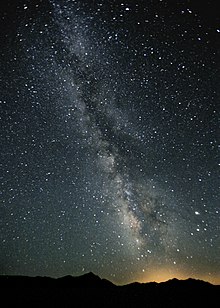



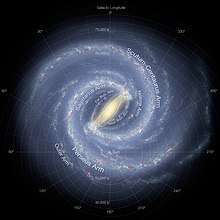
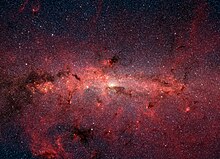
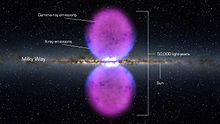
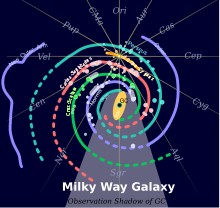




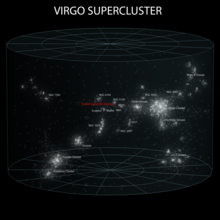


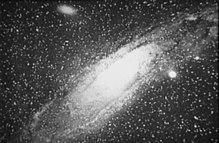
 Posted in:
Posted in:
2 comments:
My spouse and I stumbled over here different web page and thought I might check things out.
I like what I see so now i am following you.
Look forward to checking out your web page repeatedly.
Look into my web-site google; http://google.com/,
Thank you for the support
Post a Comment